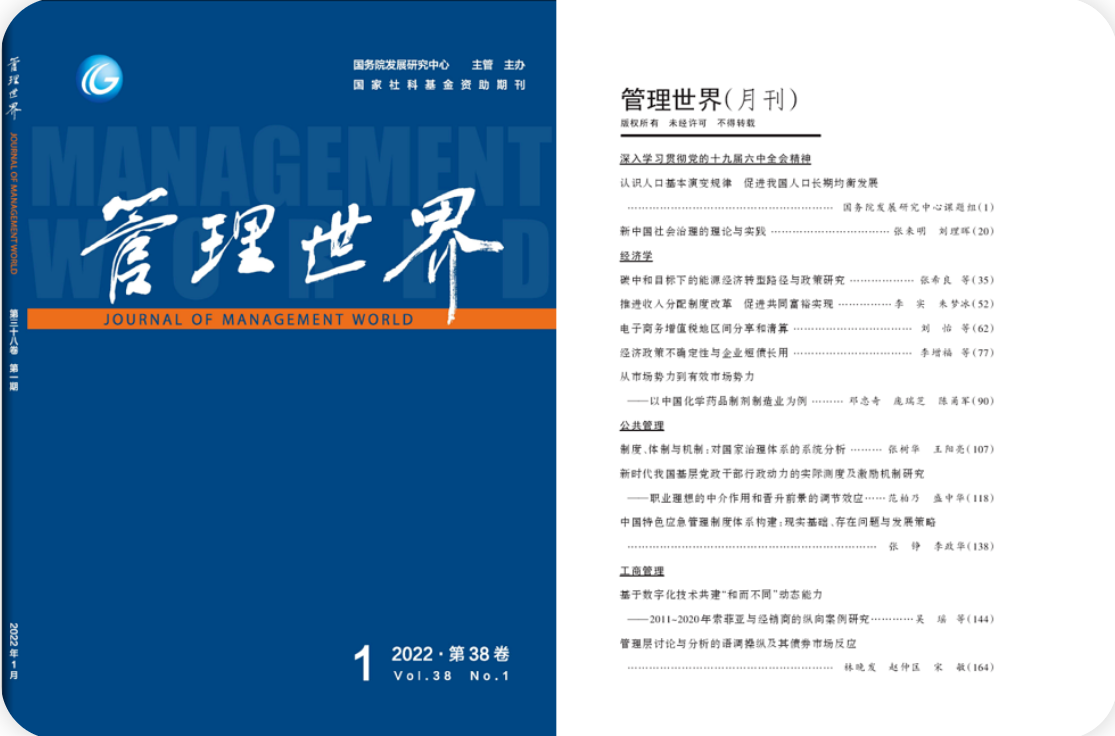岭南观点·33 电子商务增值税地区间分享和清算
聂海峰副教授、刘怡教授、崔小勇副教授、阿里研究院张凌霄
我院聂海峰副教授与北京大学刘怡教授、崔小勇副教授和阿里研究院张凌霄合作的论文 《电子商务增值税地区间分享和清算》于2022年1月在经济学中文顶级期刊《管理世界》发表。

电子商务的发展在提高商业效率、便利人民生活的同时,显著地改变了传统的销售商品和提供服务产生的增值税收入在地区之间的分布。传统模式中,商品的零售和消费大多在同一个地区,交易所产生的税收由当地政府获取,并用于辖区公共物品和公共服务的提供。传统商业模式流通环节非常重要,而中间渠道的存在使得交易和消费的地域非常接近,产业链的价值在地域之间分配相对均匀。电子商务技术压缩了渠道,搜寻成本的降低减少了中间环节,数字化设计和灵活生产,使得“销售极化消费均化”的现象日益显著。当商品的生产销售和消费处于不同区域时,如何划分税收收入的归属将对不同地区政府的税收收入和公共服务能力产生重要的影响。
数据显示,电子商务零售交易中超过80%的交易是跨省交易。增值税是对交易征收的税收,分享交易产生的增值税有生产地原则和消费地原则两种基本原则。我国当前主要按生产地原则在地区间分享增值税。通俗来说,电子商务的跨地区交易产生的增值税归属于卖方所在地,改为消费地原则就是由买方所在地获得交易的增值税。由于销售方和购买方位于不同的税收管辖区,使得电子商务交易的税收引起地区间税收转移和税负输出。当生产和消费分属于不同的地方政府管辖时,生产地政府得到税款,消费地居民负担税款,会出现税收收入归属和税收负担归属不一致。这种不一致可能限制电子商务发展的市场一体化效应,加剧区域间横向财力不均、而且可能扭曲资源配置。
该文的主要研究内容:
在理论分析方面,对比了生产地原则和消费地原则分配增值税时,电子商务发展对各地政府税收和社会福利的影响。在生产地原则下,电子商务发展可能恶化地区福利;而在消费地原则下,电子商务发展促进地区福利帕累托改进。从生产地原则改变为消费地原则分配税收,更加适合电子商务时代市场一体化和跨地区交易增加的现实,地区的公共物品提供依赖当地消费而不是当地生产。在生产地和消费地适当分配跨地区交易的税收,可以实现电子商务发展对各地区福利的帕累托改进。
在经验分析方面,使用国内某电商平台上2013~2015年各类商品和服务的购买和销售金额数据分析了税收区域分布,测算了不同分配方案对电子商务增值税地区分布的影响。通过对各省销售和购买数据的分析,发现电子商务发展区域分布表现出了两个特点:首先,跨省的消费和销售偏离明显;其次,各省交易流净额持续扩大。根据跨地区交易增值税的生产地原则和消费地原则等多种组合改革方案分配增值税的测算分析表明:由于“销售极化消费均化”的电商销售地区分布特征,税收收入分配从生产地原则调整为消费地原则时,随着跨地区交易税收分配给消费地的比例增加,地区之间税收分布的不平等程度将逐渐下降。
该文的学术贡献主要体现在以下三个方面:
第一, 通过理论模型分析表明实行消费地原则分配增值税可以实现电子商务市场一体化发展的帕累托改进优势。
第二, 使用中国某电子商务平台的销售和购买的数据,全面分析了电子商务销售流转和增值税分布的情况,测算了在不同增值税分享原则下,电子商务交易产生的增值税的地区分布。
第三, 首次提出通过跨地区省际增值税清算机制实现消费地原则,这个机制属于增量改革,更易于执行,符合增值税分享体制完善的方向。
该文的主要结论与政策建议:
电子商务增值税地区分配改革方案有两种思路:第一种思路是专案处理,第二种思路是作为增值税地区间分配方案的一部分统一处理。专案处理的优势是对各地区增值税收入整体规模影响较小,容易执行,但需要区分电商交易和非电商交易,可能不利于不同商业模式融合。建议将电子商务增值税跨区域分配作为增值税跨区域分配改革的一部分,可行的方案是在征管中仍然采用现行制度,在税收分配中引入消费地原则,通过省际增值税清算实现消费地原则分配税收,将电商跨区域销售的税收问题结合在增值税地区分享制度改革一起解决。
在省际增值税清算机制中,对于跨区域的发票销项和进项进行清算,通过中央对清算资金进行转移。各省区都得到了本辖区内消费的增值税收入,可以实现增值税按消费地原则在地区之间分配。相比其他方法,省际增值税清算机制具有如下的特点:第一,省际增值税清算不仅可以解决电子商务跨区域销售的问题,而且可以应用于传统的线下交易,符合电子商务线上线下融合的趋势。第二,通过国家税务局征管增值税和地区间清算,能够保证增值税链条完整,有利于征管制度完善。第三,省际增值税清算制度是增量改革,便于和当前省以下增值税收入分享制度衔接,各省可以根据情况自行制定合适的省以下收入划分制度,有利于各地探索和试验。第四,有助于区域一体化探索。比如京津冀地区,可以作为一个整体与其他省或者区域清算。

Summary
There are two main principles to distribute the tax revenue fromtransactions: Origin Principle and Destination Principle. In the OriginPrinciple, the tax revenue of transaction is submitted to the seller's taxauthority. In the Destination Principle, the value-added tax of transaction issubmitted to the buyer's tax authority. When China's value-added tax wasestablished in 1994, the Origin Principle was used. The Origin Principle givesstrong incentives for the government to take measures to promote the economicgrowth. However, in the Origin Principle the local governments pay lessattention to environmental protection and better public service to the localresidents, which make it hard to attract the talents. Keen and Hellerstein(2010) survey the theoretical literature of the comparison of the twoprinciples. They find that, although both principles receive support fromtheoretical model setups, the Destination Principle is more widely used in taxpolicy practice among federal countries.
We use the domestic sale data from a famous e-commerce platform tomeasure the tax revenue inequality from the sale of e-commerce. Under theOrigin Principle, the Gini coefficient of distribution of provinces' taxrevenue is 0.75. If the tax revenue was allocated according to the DestinationPrinciple, the Gini coefficient would have decreased to 0.46. We also simulatethree reform plans with the percent of tax revenue apportioned to the seller'stax authority set at 75%, 50% and 25%. We find that the corresponding Ginicoefficient of inter-regional tax revenue distribution would be 0.67, 0.60 and0.54. The simulation results show that the lower the proportion allocated tothe place of production, the lower the Gini coefficient of inter-regional taxrevenue distribution.
Since 2016, the business tax and the value-added tax have merged, andChina's value-added tax has become an integrated tax on goods and services.Distributing the tax revenue according to the Destination Principle will be thenext step to improve China' value-added tax system. This tax reform would notonly make the distribution of tax revenue more balanced among regions, but alsohelp local governments adapt to the change of economic growth pattern andprovide a direct link between local consumption and local government revenue,reducing the institutional barriers to the formation of a unified nationale-commerce market.
According to the actual situation of China, we propose to use theannual value added tax settlement of inter-provincial transaction to implementthe Destination Principle. The value of inter-provincial sales and the value ofinter-provincial purchase of every province are cleared by the centralgovernment. The value- added tax of net value of sale and purchase is remittedto the province by the central government. Our proposal has many merits. Firstof all, the annual value added tax settlement of inter- provincial transactionnot only solves the problem of cross- regional sales of e-commerce, but alsoconforms to the trend of online-to-offline integration of e-commerce. Secondly,the value-added tax settlement of inter-provincial transaction is feasible,because through the National Tax Bureau's collection and management ofvalue-added tax and inter-regional settlement, to ensure the integrity of thevalue-added tax chain, facilitate the collection and control system. The incomefrom settlement is returned to the province as tax revenue, which is on a soundbasis of established institution. Third, the settlement mechanism is anincremental reform, which is convenient to link up with the current value-addedtax sharing system under the province. Each province may, according to its owncircumstances, formulate an appropriate allocation method within the province,which is conducive to local exploration and testing. Fourth, the settlementmechanism contributes to the exploration of regional integration. For example,the Beijing-Tianjin-Hebei region can act as a whole to settle with other provinces.

聂海峰
中山大学岭南学院副教授,研究领域为公共经济学,中国财政,税收理论等。研究论文发表在《管理世界》、《经济研究》、《财政研究》、《税务研究》等核心和专业期刊。主持过国家自然科学基金等多项学术课题研究。



